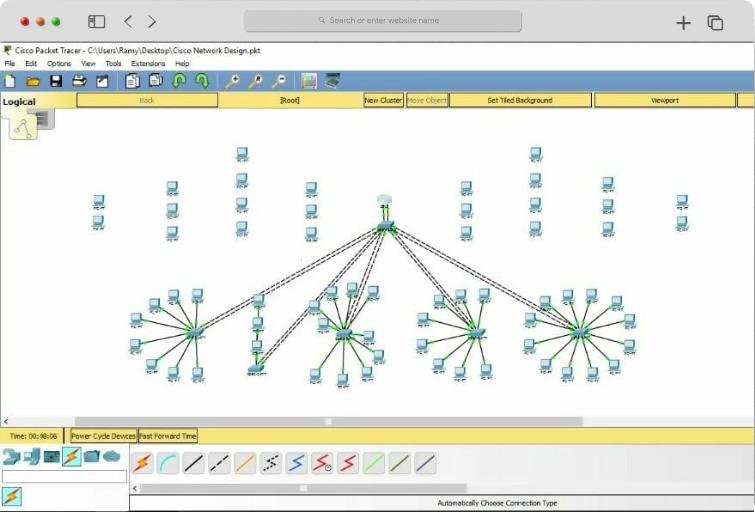CCNA
ssd
Cisco Networking Academy

The Cisco Networking Academy at SNIST has been successfully established, since June 2018. SNIST is preparing students to meet the demands and enormous opportunities of the information economy while creating a competent and talent pool for building and maintaining local, national and global business networks.The CCNA curriculum prepares students to plan, install, operate and to troubleshoot TCP/IP, Ethernet, Routed and Switched networks with some remote connectivity.
Cisco Networking Academy Orientation
ssd
Cisco Networking Academy
Dr.V.Jayaprakasan
Professor | ECE
- +91 9842645707
- jayaprakasanv@sreenidhi.edu.in
Dr.Vyomal Pandya
Associate Professor | ECE
- +91 846403388
- vyomalpandya@sreenidhi.edu.in
Mr.Md.Baba Fareeduddin
Assistant Professor | ECE
- +91 944078687
- babafareedud@sreenidhi.edu.in
ssd
Course Description
CCNA Routing and Switching teaches comprehensive networking concepts, from network applications to the protocols and services provided to those applications by the lower layers of the network. Students will progress from basic networking to more complex enterprise and theoretical networking models later in the curriculum. In each course, Networking Academy™ students will learn technology concepts with the support of interactive media and apply and practice this knowledge through a series of hands-on and simulated activities that reinforce their learning.
Introduction to Networks
Introduces the architecture, structure, functions, components, and models of the Internet and other computer networks. The principles and structure of IP addressing and the fundamentals of Ethernet concepts, media, and operations are introduced to provide a foundation for the curriculum. By the end of the course, students will be able to build simple LANs, perform basic configurations for routers and switches, and implement IP addressing schemes.
Routing and Switching Essentials
Describes the architecture, components, and operations of routers and switches in a small network. Students learn how to configure a router and a switch for basic functionality. By the end of this course, students will be able to configure and troubleshoot routers and switches and resolve common issues with static route, RIPv2, VLAN, NAT, ACL, DHCP in both IPv4 and IPv6 networks, and perform device discovery, management and maintenance.
Scaling Networks
Describes the architecture, components, and operations of routers and switches in a large and complex network. Students learn how to configure routers and switches for advanced functionality. By the end of this course, students will be able to configure and troubleshoot routers and switches and resolve common issues with OSPF, EIGRP, STP, and VTP in both IPv4 and IPv6 networks. Students will also develop the knowledge and skills needed to implement DHCP and DNS operations in a network.
Connecting Networks
Discusses the WAN technologies and network services required by converged applications in a complex network. The course enables students to understand the selection criteria of network devices and WAN technologies to meet network requirements. Students learn how to configure and troubleshoot network devices and resolve common issues with data link protocols. Students also develop the knowledge and skills needed to implement IPSec and virtual private network (VPN) operations in a complex network.
ssd
Cisco Packet Tracer

Cisco Packet Tracer is a powerful network simulation program that allows students to experiment with network behavior. As an integral part of the Networking Academy™ comprehensive learning experience, Packet Tracer provides simulation, visualisation, authoring, assessment, and collaboration capabilities and facilitates the teaching and learning of complex technology concepts. Packet Tracer complements the Networking Academy curricula, allowing the students to understand the complex technical concepts and networking systems design easily. Students can build, configure, and troubleshoot networks using virtual equipment and simulated connections, alone or in collaboration with other students.
ssd
Curriculum Features & Benefits
Students learn the basics of routing, switching, and advanced technologies to prepare for the CCENT and CCNA certification exams, networking related degree programs, and entry-level careers.
- Networking Academy courses are designed to develop the breadth and depth of knowledge and skills that employer’s desire.
- Students are prepared for Cisco and other highly valued IT certifications to increase employability and salaries.
- Networking Academy courses are designed to develop the depth of knowledge and skills that employer’s desire.
- Students learn the basics of routing, switching, and advanced technologies to prepare for the CCENT and CCNA certification exams, networking related degree programs, and entry-level careers.
- The language used to describe networking concepts is designed to be easily understood by learns at all levels and embedded interactive activities help reinforce comprehension.
- Courses emphasize critical thinking, problem solving, collaboration, and practical application of skills.
- Multimedia learning tools, including videos, games and quizzes, address a variety of learning styles and promote increased knowledge retention.
- Hands-on labs and Cisco Packet Tracer simulation-based learning activities help students develop critical thinking and complex problem solving skills.
ssd
Cisco Certifications
Getting Cisco certified can be quite the process, learn how to prepare you for success. Understand how certifications fit into your overall career goals and how to make them a reality. Students will be prepared to take the Cisco CCENT® certification exam after completing a set of two courses and the CCNA® Routing and Switching certification exam after completing a set of four courses.
Here are some examples of tasks students will be able to perform after completing each course:
Introduction to Networks
Introduces the architecture, structure, functions, components, and models of the Internet and other computer networks. The principles and structure of IP addressing and the fundamentals of Ethernet concepts, media, and operations are introduced to provide a foundation for the curriculum. By the end of the course, students will be able to build simple LANs, perform basic configurations for routers and switches, and implement IP addressing schemes.
Routing and Switching Essentials
Describes the architecture, components, and operations of routers and switches in a small network. Students learn how to configure a router and a switch for basic functionality. By the end of this course, students will be able to configure and troubleshoot routers and switches and resolve common issues with static route, RIPv2, VLAN, NAT, ACL, DHCP in both IPv4 and IPv6 networks, and perform device discovery, management and maintenance.
Scaling Networks
Describes the architecture, components, and operations of routers and switches in a large and complex network. Students learn how to configure routers and switches for advanced functionality. By the end of this course, students will be able to configure and troubleshoot routers and switches and resolve common issues with OSPF, EIGRP, STP, and VTP in both IPv4 and IPv6 networks. Students will also develop the knowledge and skills needed to implement DHCP and DNS operations in a network.
Connecting Networks
Discusses the WAN technologies and network services required by converged applications in a complex network. The course enables students to understand the selection criteria of network devices and WAN technologies to meet network requirements. Students learn how to configure and troubleshoot network devices and resolve common issues with data link protocols. Students also develop the knowledge and skills needed to implement IPSec and virtual private network (VPN) operations in a complex network
ssd
Employability Skills
The students are learning about Network fundamentals, Routing and Switching, Scaling of Networks and Connecting Networks in detail. This course emphasizes critical thinking, problem solving, collaboration and practical applications of skills. In addition, CCNA Certification improves the confidence towards placement opportunities.
Job Positions and Opportunities, in Telecom Companies, Every MNC’s as Network Engineer, IT Manager, Network Administrator, etc.,
To learn more, visit www.netacad.com





